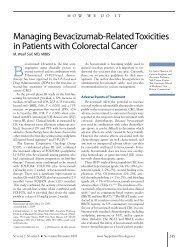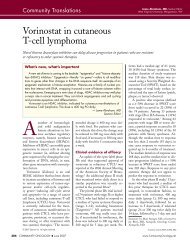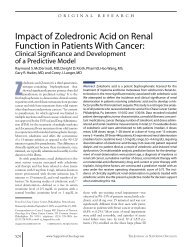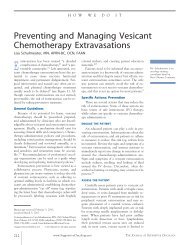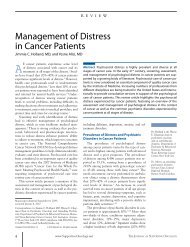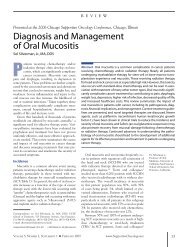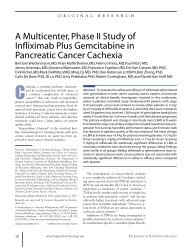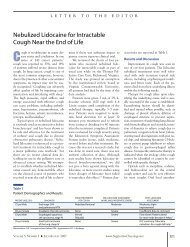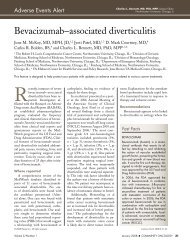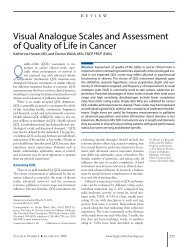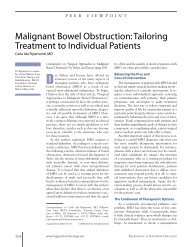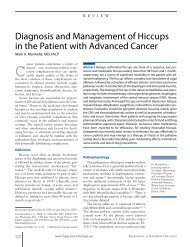Volume 9 Number 3 March 2012 - Oncology Practice Digital Network
Volume 9 Number 3 March 2012 - Oncology Practice Digital Network
Volume 9 Number 3 March 2012 - Oncology Practice Digital Network
Create successful ePaper yourself
Turn your PDF publications into a flip-book with our unique Google optimized e-Paper software.
Review<br />
6-Month first event rate, %<br />
12<br />
11<br />
10<br />
9<br />
8<br />
7<br />
6<br />
5<br />
4<br />
3<br />
2<br />
1<br />
0<br />
Treatment first received<br />
Time to first event, months<br />
At risk:<br />
A:<br />
T:<br />
N = 3,092<br />
N = 3,094<br />
2,593<br />
2,701<br />
2,311<br />
2,429<br />
2,083<br />
2,184<br />
1,902<br />
2,023<br />
1,755<br />
1,874<br />
1,621<br />
1,724<br />
1,528<br />
1,603<br />
1,420<br />
1,481<br />
1,297<br />
1,345<br />
Anastrozole<br />
Tamoxifen<br />
0 6 12 18 24 30 36 42 48 54 60 66<br />
711<br />
772<br />
FIGURE 1 Time to onset of first joint symptom event in the ATAC trial.<br />
The 6-month first event rate D/S, where D is the decrement in the<br />
Kaplan-Meier event-free estimate over the previous 6 months and S is<br />
the Kaplan-Meier estimate 6 months before the time point. Reprinted<br />
with permission from Mackey J, Gelmon K. Adjuvant aromatase inhibitors<br />
in breast cancer therapy: significance of musculoskeletal complications.<br />
Curr Opin Oncol. 2007;19:S9-S18, 31 originally appeared in<br />
poster by Buzdar AU, presented at 2006 ASCO meeting.<br />
5<br />
13<br />
was conducted in the ATAC study (Figure 1). 10,30,31 This<br />
subanalysis showed that the event rate for joint symptoms<br />
peaked within 6 months after initiation of AI therapy and<br />
decreased thereafter. The majority of events (anastrozole,<br />
68%; tamoxifen, 59%) were reported within 24 months of<br />
AI therapy initiation. 10 Among patients reporting joint<br />
symptoms, 46% had exacerbation of an existing condition.<br />
10 In addition, patients who received prior chemotherapy<br />
had a higher incidence of joint symptoms and a<br />
shorter median time to onset (TTO). 31 A recent analysis<br />
of the Breast International Group (BIG) 1-98 study<br />
showed that the incidence of arthralgia/myalgias in patients<br />
who received letrozole was higher in years 1 and 2<br />
than in years 3-5 (26% vs. 14%, respectively). 32 A recent<br />
1-year, prospective, joint-symptom evaluation in a clinical<br />
practice involving 58 postmenopausal women who initiated<br />
AI therapy showed that MSS were increased from<br />
baseline at both 3 and 6 months after treatment began. 33<br />
Rheumatologic evaluation of the hands showed worsening<br />
function, stiffness, and pain at 3 months; however, only<br />
function continued to worsen at the 6-month evaluation,<br />
when a significant decrease in pinch grip strength was noted<br />
(P .05). The 1-year results were not available.<br />
Several AI studies have reported a median TTO of<br />
arthralgia, which yields more precise timing of onset. In a<br />
study involving 97 postmenopausal women who were<br />
randomized to either exemestane or letrozole for 1 year,<br />
44 women met the criteria for rheumatologic evaluation.<br />
34 Among those evaluated, the median TTO was 1.6<br />
months (range, 0.4-10 months). In another study involving<br />
24 patients who were referred for rheumatologic evaluation,<br />
the median TTO was 2.5 months. 5 The timing of<br />
arthralgia in these two AI studies was similar to what was<br />
observed in 102 premenopausal women receiving leuprolide,<br />
a drug that reduces hormone production to menopausal<br />
levels; the timing suggested that estrogen deprivation<br />
may be involved in the development of arthralgia. 35<br />
In fact, the prevalence of arthralgia peaks in women<br />
during menopause (age 50-59 years). 15,35 In this study,<br />
the AEs of estrogen deprivation (such as vaginal dryness)<br />
began 2 weeks after leuprolide initiation and corresponded<br />
to the decline of estradiol to menopausal levels.<br />
The development of arthralgias and myalgias began during<br />
weeks 3-7 of therapy, with 25% of patients experiencing<br />
symptoms. 35 Symptoms resolved at 2-12 weeks<br />
after discontinuing leuprolide treatment. In a separate<br />
study, conjugated estrogen therapy in postmenopausal<br />
women reduced the risk of developing MSS by up to 38%,<br />
compared with placebo. 35<br />
These studies suggest that a high percentage of postmenopausal<br />
women with breast cancer may be predisposed<br />
to develop joint symptoms, or may have a preexisting<br />
joint condition. Therefore, in general, arthralgia<br />
that is related to estrogen suppression may worsen or<br />
develop within the first few months of AI treatment<br />
initiation, and subside within a few months after treatment<br />
has been discontinued.<br />
Potential etiologies for MSS with AI use<br />
Despite increased awareness of the clinical importance of<br />
AI-associated MSS, the mechanisms underlying symptom<br />
development remain poorly understood. Given<br />
symptom variability, multiple etiologies likely can lead to<br />
the development of MSS in individual patients on AI<br />
therapy. 5 Several potential mechanisms have been discussed<br />
in recent reviews, including estrogen deprivation,<br />
inflammatory or autoimmune response, the direct offtarget<br />
effect of AIs or their metabolites, and vitamin D<br />
deficiency. 5,36,37 Identification of the mechanisms leading<br />
to MSS may facilitate the development of directed approaches<br />
for symptom management.<br />
A recent case-control, genomewide association study of<br />
patients in the National Cancer Institute of Canada Clinical<br />
Trials Group (NCIC CTG) MA.27 phase III study of<br />
anastrozole and exemestane identified four single-nucleotide<br />
polymorphisms that were related to the incidence of grade 3<br />
or 4 musculoskeletal symptoms. 38 Genetic polymorphisms<br />
in CYP19A1 (the final enzyme in estrogen synthesis) is also<br />
associated with patient-reported arthralgia. 39 Further investigation<br />
of these genetic variations may lead to a better<br />
understanding of the mechanism, more effective symptom<br />
management, and earlier identification of patients at risk of<br />
developing arthralgia.<br />
96 COMMUNITY ONCOLOGY <strong>March</strong> <strong>2012</strong> www.Community<strong>Oncology</strong>.net



